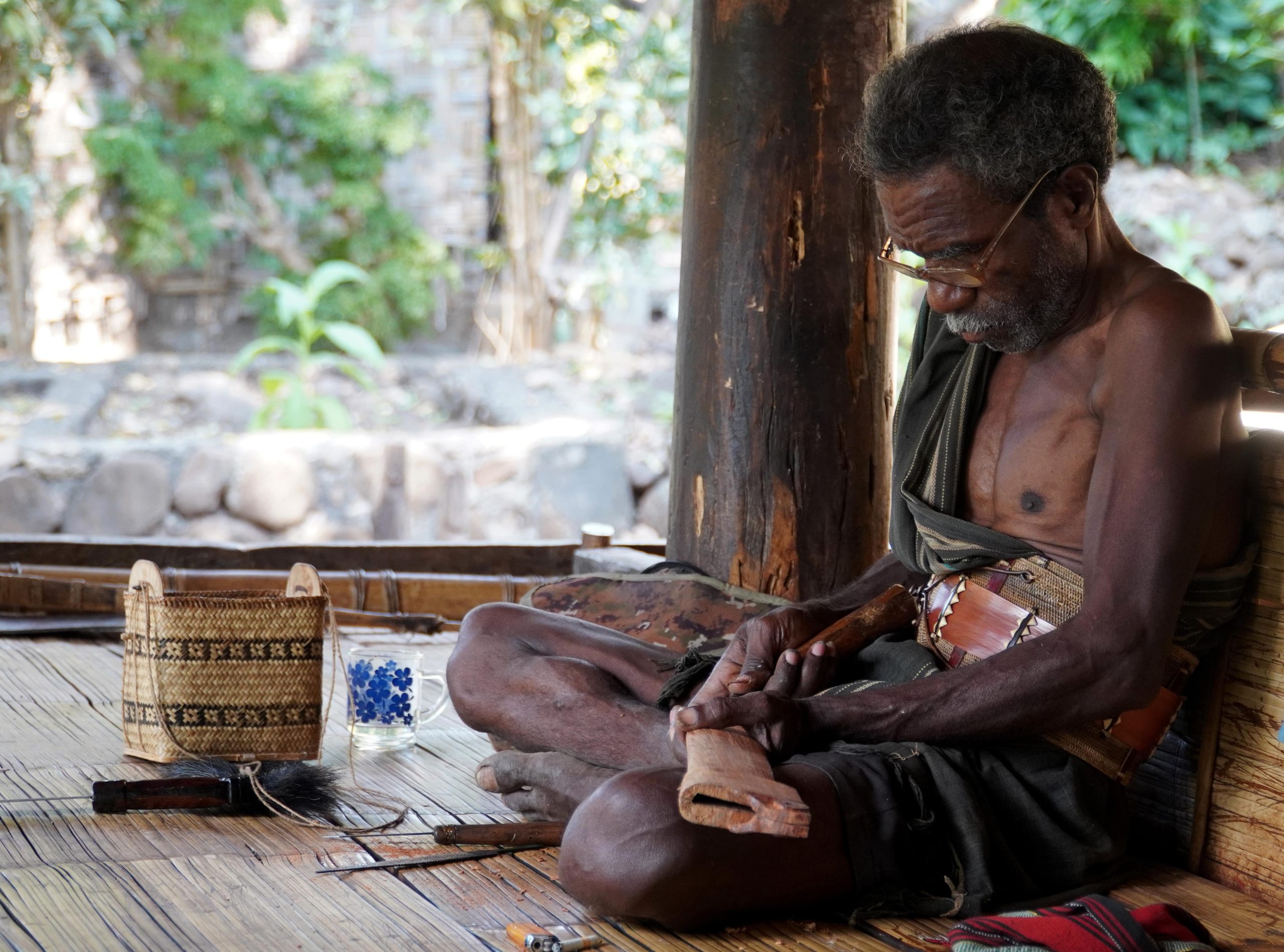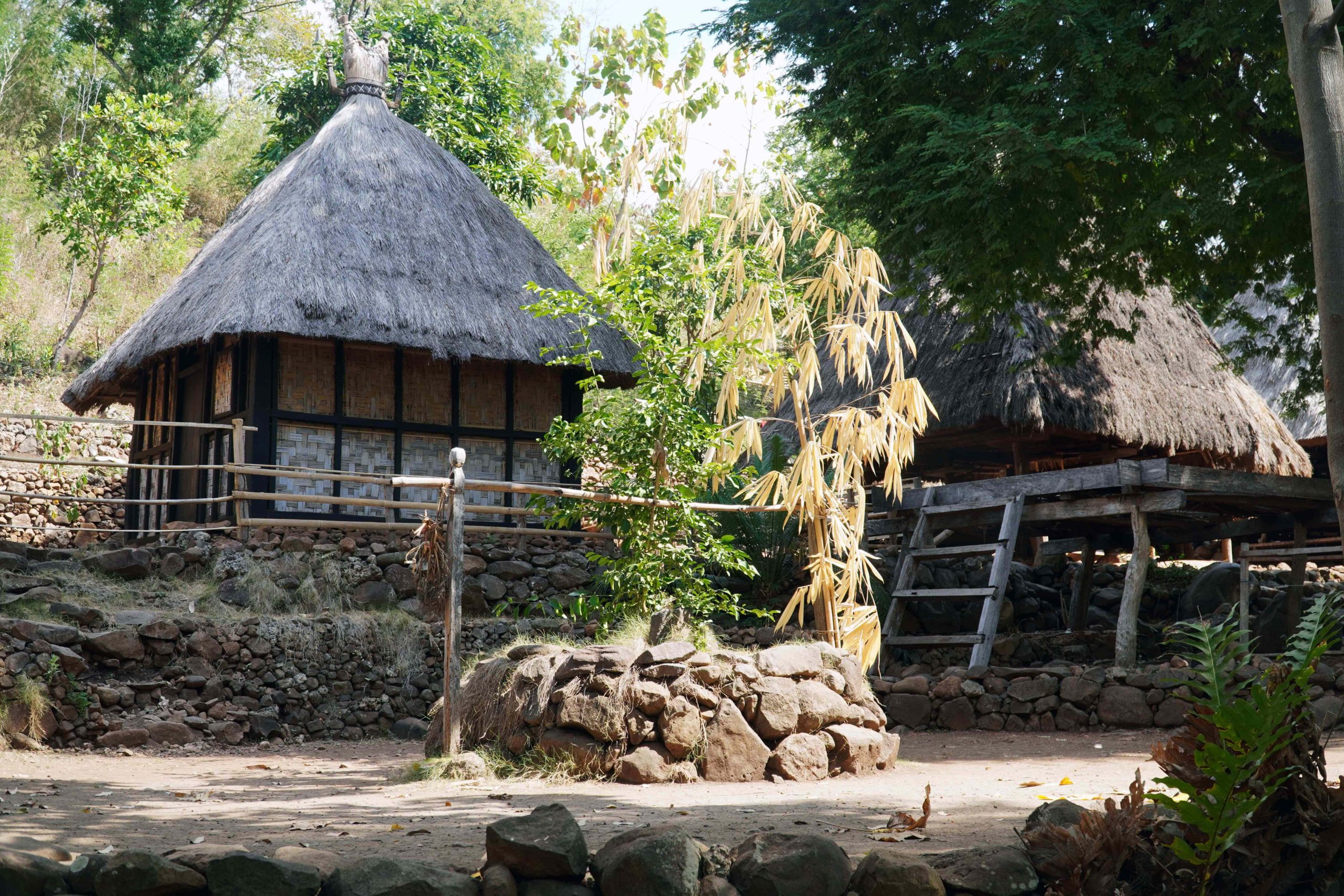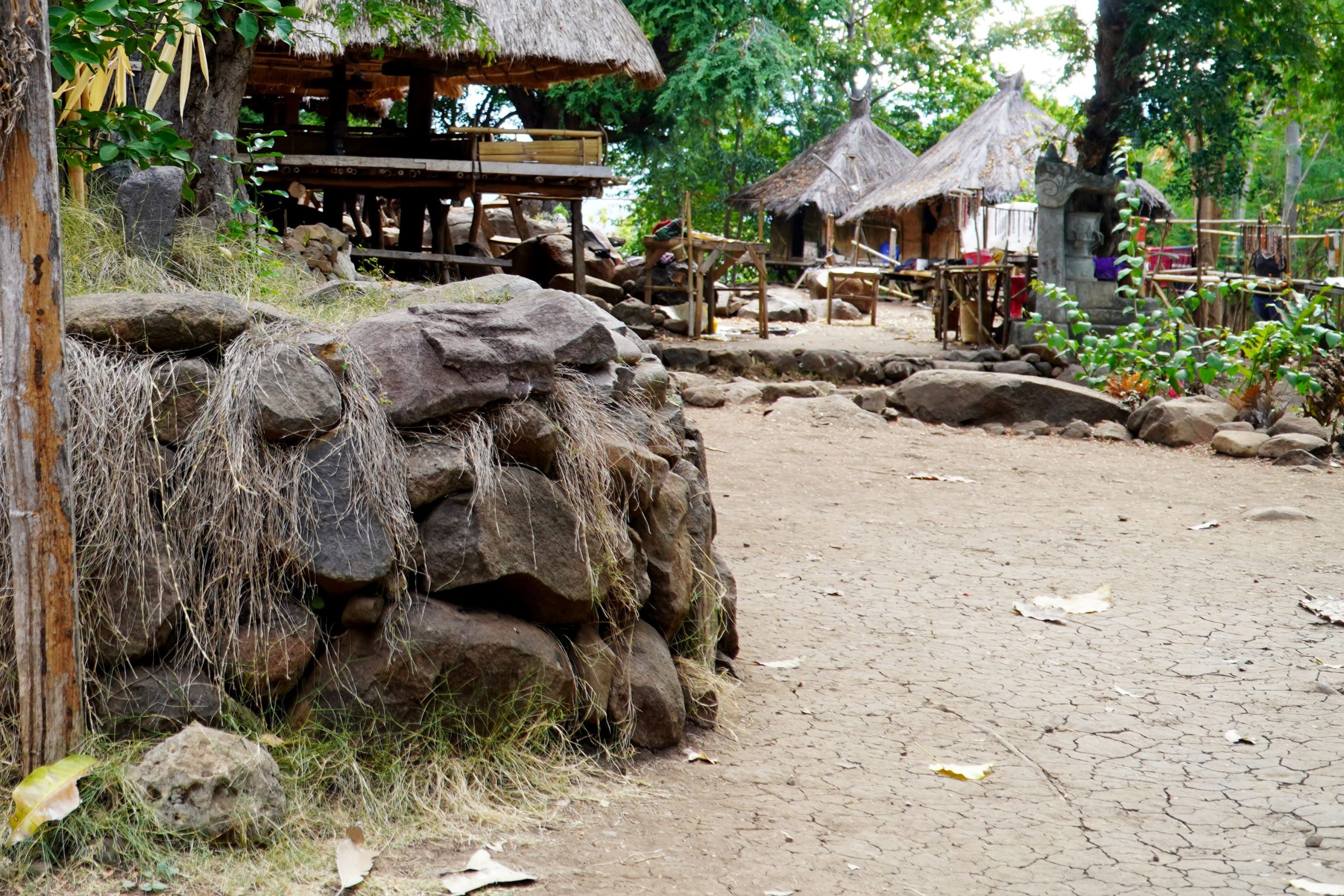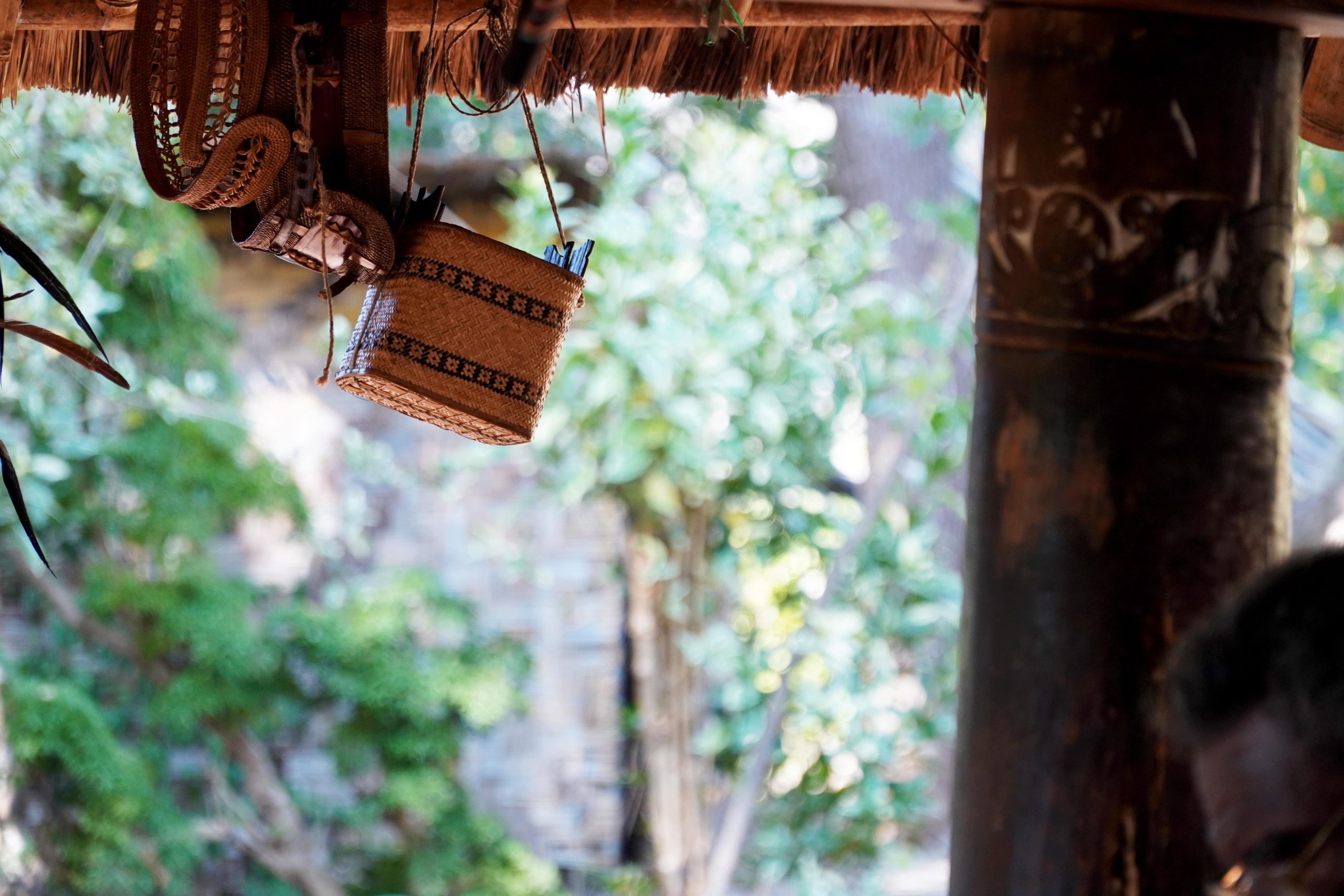
As I stood on the hillside, I found myself lost in the view of the blue sea and a hill around. The breathtaking view was… This captivating view was my companion on the journey to Takpala, one of the traditional villages in Alor. The village location is quite strange, perched between the mountains and the sea, reachable only after a 30-minute ride from the coast up into the hills. Its location, tucked away between hills and slopes, adds to its allure, offering stunning panoramas at every turn.
It was around one in the afternoon when I arrived, the sky clear and bright as I parked my motorcycle. I hadn’t anticipated the beauty that awaited me even from the parking lot—a breathtaking expanse of sea framed by hills, a sight that made me pause to fully take it in.
“Please, take a seat. You must be tired after the climb,” Mr. Sepri, the head of the Takpala Village arts group, greeted me warmly as he accepted the betel nut I had brought. Beside him sat an elder, quietly carving the handle of a parang, the traditional knife that is an essential tool for the villagers in their daily farming tasks.
Mr. Sepri then smiled and directed me to speak with the elder. “This is Abner Yetimauh,” he introduced him.
As I caught my breath, our conversation began with the history of Takpala Village, located in West Lemburu Village, north central Alor.
Mr. Abner shared the story of his people, “The people of Takpala Village have lived here since the 1940s. Originally, our ancestors came from a much more distant region, but circumstances led the Village Head at the time to move us to this current location.” In 1984, a Mesbah, or stone altar, was constructed for the traditional lego-lego dance, a crucial part of their cultural practices.

Today, Takpala is home to about 40 people, divided into eight families, living in 14 traditional houses known as Fala Foka. The villagers belong to three clans: Kapitang, Aweni, and Marang. Each clan has its role within the community—Kapitang as warriors, Aweni as village leaders, and Marang as delegates, which is also Mr. Abner’s lineage.
The village language is Abui, but as Mr. Abner clarified, “Abui is not a tribe, as some might think. Abui refers to the people of the mountainous regions, while Habang refers to those who live along the coast.”
The distinction between these regions is more than just geographical; it’s cultural. For instance, in the lego-lego dance, Abui people stand in a circle, linking arms at the shoulders or waist, while the Habang hold hands.
The lego-lego dance is more than just a performance; it’s a prayer, a call to the ancestors for blessings and protection. The dance is performed around the Mesbah, with prayers and songs in the Abui language. The only accompaniment is the sound of women’s bracelets clinking as they dance, creating a rhythmic, almost meditative atmosphere.
Through this dance, the Takpala community also prays for preserving the forest and its surroundings. The name Takpala reflects this—’Tak’ means boundary, and ‘Pala’ means wood, a nod to the community’s deep-rooted tradition of protecting the Alor forest.
Beyond its spiritual significance, the lego-lego dance also plays a role in maintaining two traditional houses, which serve as storage for the village’s historical and ancestral items. These sacred items are kept within the Lopo, a unique house made of bamboo weaving and located on the east and west sides of the village.
“The eastern side is white, and the western side is black. Anyone may enter the black house, but the white house is restricted, only for a selected ceremony or the elders,” Mr. Abner explained, gesturing towards the Lopo houses.

The opening of the Lopo is a solemn event, permitted only once a year by the Marang clan. The privilege of opening the Lopo is reserved for the eldest or firstborn, underscoring the deep respect for tradition and lineage in Takpala.
Another significant dance in the community is the Cakalele, a traditional war dance that is now also used to welcome guests. Cakalele is performed by adult men wearing knowing (traditional cloth), maisalah (headband), basah (a belt made of rattan and palm leaves), Karol (a betel nut pouch), and traditional weapons—either bows or machetes called sora. The dance mimics battle movements, with the dancers holding their weapons in rhythm, reenacting the village’s martial heritage.
These weapons are not just for show but also for hunting, with pigs and deer being the primary game. According to Mr Abner, these animals are believed to come from the deity’s hole, a sacred place, and are seen as an endless blessing to the village.
“Our ancestors taught us that pigs and deer will come out of the deity’s hole to feast on our crops, and when the season ends, they return to the hole,” he shared with a bright smile, embodying the village’s deep connection to nature.
As we talked, the village felt serene and quiet. Most villagers were away, participating in the Independence Day parade in Kalabahi city, leaving only a few women behind, busy making trinkets for visiting tourists.

Our conversation paused when Mr. Sepri kindly offered us hot coffee. “Let’s drink while it’s hot,” he said, and the bitter-sweet taste of the coffee, combined with the tranquil village atmosphere, made the moment feel timeless.
Yet, the mood shifted slightly when I asked about changes in Takpala. Mr. Abner quickly corrected me—what I called change, he preferred to see as adjustment. His voice was firmer as he explained that the Takpala people remain committed to their traditions, performing rituals and worshipping their ancestors to keep their culture alive. The most recent ritual, Tifol Tol, was held in July to seek blessings before the planting season began.

However, some adjustments have been necessary. The village’s water source was destroyed by Cyclone Seroja in 2021, forcing the community to rely on water from Kalabahi. Electricity, too, has become a part of village life, though mainly for lighting and charging phones. Despite this, Mr Abner remains largely unplugged, preferring the simplicity of life without a mobile phone, though the village head, Mr Sepri, does carry a large satellite phone to stay connected for village business.
“If you’re free tomorrow, join us in picking up the priest at Mali airport. After that, we’ll have a service at the Maria cave in Tombang,” Mr Sepri invited, reflecting the strong Catholic faith that now complements the village’s traditional beliefs.
As our conversation drew to a close, Mr. Abner reflected on the pace of modern life. “Things have advanced so much now. People can communicate across seas instantly, but I miss the old ways of walking to someone’s place to visit or talk. It kept our community united,” he mused.
“Traditions don’t change because customs and traditions are the foundation of life,” he concluded.
I hadn’t realized how much time had passed until I saw the coffee grounds at the bottom of my cup. I had been in Takpala for two hours, and it was time to leave. I thanked Mr. Sepri and Mr. Abner for their time and began to gather my things.
As I prepared to depart, Mr. Abner, who had been busy carving, stopped and walked with me to the village gate. He pointed once more to the Mesbah we passed, the stones symbolizing the three clans of Takpala.
“If you have free time, come back here,” he said, shaking my hand warmly in farewell.
Experience the unforgettable in Takpala Village with the Conservation Experience, brought to you by Thresher Shark Indonesia and Acaloca in October 2024. Sign up here!